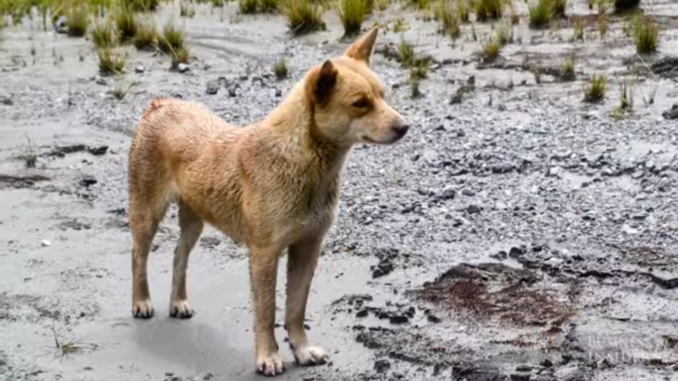
Thousands of years ago, during the Great Ice Age, sea levels were much lower than they are now. Australia and New Guinea were a single island thanks to the Sahul Shelf being above sea level. Likewise, many of the islands that constitute the nations of Indonesia and Malaysia were connected by the Sunda shelf, which was above sea level.

An ancient breed of dogs found their way to these islands from Asia, either on their own or likely they came along with migrating humans. Modern dingoes, the feral dogs of Australia, are descendents of these ancient canids. Now a wild dog thought to be extinct since the 1970s, genetically very close to the dingo, has been found high in the mountains of New Guinea. This line of Canis familiaris has been proven to be even more ancient than the dingo, although DNA proves they are related.
“The world’s rarest and most ancient dog has just been rediscovered in the wild” (1:04):
The New Guinea singing dog (NGSD) was first documented as early as 1897, but sightings have always been rare due to their remote and mountainous habitat, their small population, and their innate shyness. In 1954, live specimens were collected for the Australian Museum which were sent to the Taronga Zoo in Sydney, where they were bred. Offspring from these captive NGSDs were distributed to other zoos around the world. United States zoos received their first NGSDs in the late 1950s. Today, there are approximately 300 NGSDs in captivity worldwide, and are considered the rarest dog breed of all as well as the most ancient breed. NGSDs never bark or make any other vocalizations except for a howl, which has been characterized as singing, although it is reminiscent of coyote or wolf calls. Colloquially, the breed are affectionately referred to as ‘singers’.
“New Guinea Singing Dog” (1:31):
After the early 1970s no further confirmed sightings of wild NGSDs occurred for decades, leading many to theorize the breed had become extinct. In later years some wild dogs seen in the region became known as Highland Wild Dogs (HWD), but their relation to NGSDs was unknown. American and Indonesian researchers became interested in the HWDs around 2012. After a few years of searching high in the mountains they finally located a small pack of fifteen animals in 2016. They were able to photograph HWDs of all ages and documented their findings. In 2018 blood samples were taken from this group from which a full DNA sequence was made, then compared to the genetic sequence of captive NGSDs. Researchers confirmed that NGSDs and HWDs were one and the same breed, although the captive NGSDs had lost some genes through inbreeding and the HWDs were 30% more diverse, genetically speaking.
Researchers hope that the captive line of NGSDs will be bred with the still-feral line of HWDs to restore their genetic diversity and that this breed will be saved from extinction. Being the oldest breed of all dogs, scientists also hope that much can be learned from the ‘singers’ about the common ancestors of all dog breeds.
“Dogs 101 – New Guinea Singing Dog” (4:14):
Question of the Night: The ideal dog breed is…?
